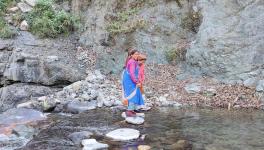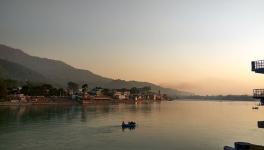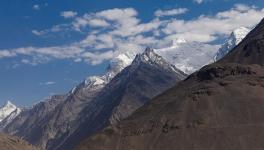Mt Abu Residents Meet NGT Panel, Flag Master Plan Problems
Transformation in Mt Abu: Stream in 2007 vs dry bed by 2016. Picture credit: Rustom Cama
A committee appointed by the National Green Tribunal (NGT) met local residents in Mt Abu on January 17, as part of proceedings in a matter challenging the town’s Master Plan-2030. Many residents who attended the meeting raised concerns about the construction proposed in the plan that puts the ecologically sensitive area at risk.
In May 2016, Mt Abu resident and well known medical doctor of the town Arun Sharma, also a member of the first committee to monitor the eco-sensitive area, approached the NGT seeking cancellation of the Master Plan. Dr Sharma’s petition noted that the Mt Abu Wildlife Sanctuary had been notified in 1960; it spreads over 290 sq km. A notification of 2009 from the Government of India had declared the area around the sanctuary an Ecologically Sensitive Zone.
Chief wildlife warden of Rajasthan, Arindam Tomar, explained that a section of the ESZ had been finalised, but the final decision on certain sections are yet to be taken.
Meanwhile, those who have already acquired land in the area are keen for the ESZ to be fixed outside their own areas, so they are not disallowed from construction. Many of the land owners hail from Gujarat and are not residents of Mt Abu. Petitioner Arun Sharma said, “Because of the ESZ, change in land use has not happened. No major commercial construction has happened, although small illegal construction has occurred.”
The 2009 notification sought restoration of denuded areas and water bodies. No change of land use from tribal to non-tribal uses would be permissible without prior approval of the state government. Quarrying and mining would be restricted, and any felling of trees would require prior permission. The notification barred “development” on steep slopes.
Also read: Over 1,500 Migratory Birds Found Dead Near Jaipur’s Sambhar Lake
Dr Sharma said the plan was drawn up without any consultation with residents or experts, and goes against the 2009 notification. It would pave the way for commercial exploitation of green areas and allow construction on steep slopes, leaving the region more prone to landslide. The plan also provides for change of land use in areas where construction has been done. “This regularisation of prior illegal structures is done in the name of ‘avoiding legal problem’,” the petition says.
The NGT stayed the implementation of the Master Plan and directed an expert committee to examine the matter. A seven-member committee, comprising Shailaja Deval of the Rajasthan state pollution control board, met residents of the town on January 17.
One local resident pointed out at the meeting that no carrying capacity study of existing infrastructure was ever conducted, as required by the 2009 notification. Such a study should ideally have listed all inventory for tourism, and arrived at a figure of the number of people who could visit and the number of vehicles that could ply towards Mt Abu.
Not only that, no inventory of already existing infrastructure as of 2009, when the ESZ notification was issued, was made. In the meantime, several new buildings sprang up and no safety limits were established for exploitation of groundwater and other resources. Traffic now routinely chokes the town streets.
A monitoring committee was supposed to oversee all development projects in the area. The 2009 notification reads, “Pending the preparation of the Zonal Master Plan for Eco-sensitive Zone and approval thereof by the Central Government in the Ministry of Environment and Forests, there shall be no increase in the existing parameters of permissible Floor Area Ratio, permissible ground coverage, maximum number of floors and maximum height and all new constructions shall be allowed only after the proposals are scrutinised and approved by the Monitoring Committee and all other development activities including additions, alterations, demolitions, repairs, renovations and restorations of buildings shall require prior approval of the Monitoring Committee provided that these do not involve structural changes and are on the existing authorised plinth areas in the Mount Abu Municipal Limits and there shall be no consequential reduction in Tribal area, Forest area, Green area and Agricultural area.”
Dr Sharma, the petitioner, was a member of the first monitoring committee, which was later disbanded. One resident of the town, who attended the meeting on January 17 and did not wish to be named, told NewsClick that attempting to manage an eco-sensitive zone without a monitoring committee was like trying to play football without a referee – there was no one to ensure rules were followed.
Construction was not permitted in green areas under the 2009 notification, but the Master Plan provides for new zones for inhabitation and commercial exploitation. The plan also makes no provision for regulation of traffic.
“Waterways, wetlands and all kinds of green areas have been constructed upon. The Zonal Master Plan has completely failed to deal with the need for reversing the unlawful constructions,” the resident added, explaining that if a proper inventory of all structures as of 2009 had existed, it would have been easier to keep track of newer–and illegal–construction.
Also read: Man-animal Conflict in C’garh Can Only Be Stopped by Human Intervention
This mushrooming of illegal structures also puts at risk the heritage buildings in Mt Abu. The region had served as a summer capital of the Rajputana state during the colonial period. The government is in possession of several buildings which are heritage structures, but poor upkeep has meant that several of them now lie decrepit. One example is the building of the Survey of India, the oldest scientific department of the Government of India. Petitioner Sharma points out that the Master Plan provides for a haat and bazaar even near the historic Dilwara temples, constructed between the 11th and 16th centuries. This addition is bound to destroy the serenity of the temple complex.
Large construction projects are planned very close to the edge of the Mt Abu Wildlife Sanctuary. There have been, as yet, no study of potential human-wildlife conflict because of these projects; such construction will increase the scale of human activity and further shrink the space available for wildlife. A wildlife census of 2015 had estimated the number of sloth bears in the sanctuary at 326 and leopards at 40.
One Mt Abu resident said, “There is no basis for allowing any new construction on open land. This is not a matter of just 10 or so mega projects, as was discussed at the meeting with the committee members.”
Shrinking space for wildlife poses hazards to human health too, as is evident from the toll taken by the new strain of coronavirus. Writing in The Hindu, Vinod Thomas of the National University of Singapore says, “The recent outbreak in China – with the SARS-CoV-2 believed to have emanated in a market where wild animals were sold – highlights the biodiversity link. Nearly two thirds of known pathogens and three quarters of newly emerging pathogens are spread from animals to humans. This dangerous trend for disease spillovers from animals to humans can be traced to increased human encroachment on wildlife territory; land use changes that increase the rate of human-wildlife and wildlife-livestock interactions; and climate change.”
The next hearing of this matter in the NGT is scheduled for March 27.
Also read: Odisha: 100 Humans Killed in Conflict with Elephants in One Year
Get the latest reports & analysis with people's perspective on Protests, movements & deep analytical videos, discussions of the current affairs in your Telegram app. Subscribe to NewsClick's Telegram channel & get Real-Time updates on stories, as they get published on our website.
























